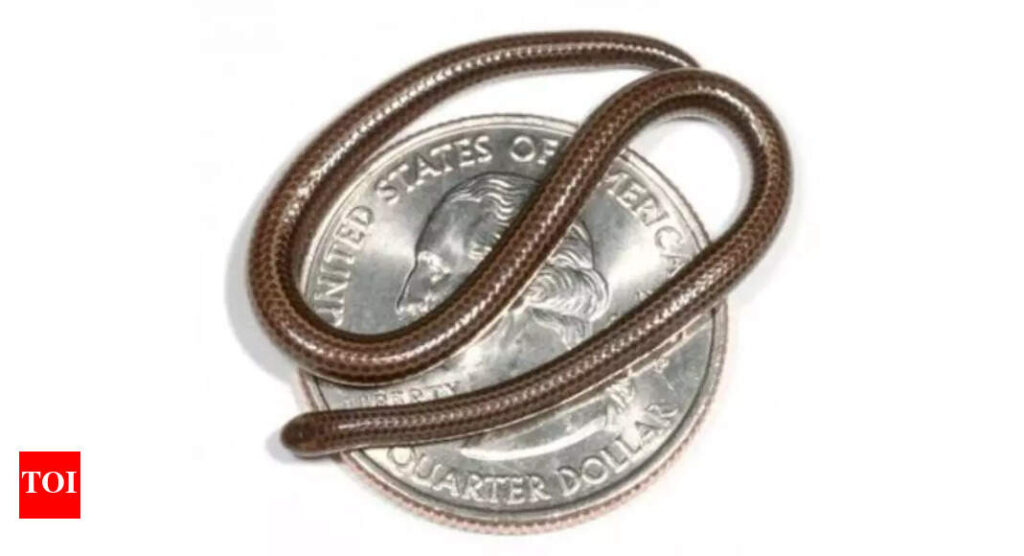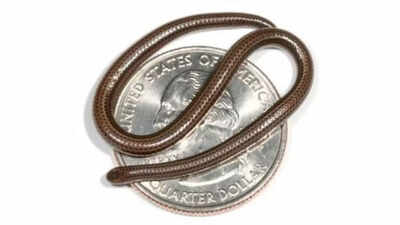Discover the world’s smallest snake measuring only 10 centimeters; know its physical characteristics, diet, and more

The tiny snakes present on this planet spend their lives underground, feeding primarily on ants and termites-a fitting diet given their miniature size. If you’ve always imagined snakes as long, slithering and a bit frightening, the Barbados threadsnake may just change your perspective because of being the smallest snake in the world, measuring only 10 centimeters. Officially the smallest snake ever recorded, it’s so petite that it can comfortably curl up on a coin.Discovered in 2008 by biologist S.Blair Hedges, the Tetracheilostoma carlae, Fewas was found in a forested area on the Caribbean island of Barbados. Measuring just over 10 centimeters , it’s shorter than most pencils and about as thin as a strand of spaghetti.These snakes belong to a group of burrowing snakes called Leptotyphlopidae. Because of their tiny size, females typically lay just one egg per clutch. Fascinatingly, the hatchling is already half the size of a full-grown adult-an unusually large proportion in the animal kingdom. Unfortunately, these miniature serpents are incredibly rare. They have only been found in a small forested region on Barbados’s eastern side-a habitat that is rapidly disappearing due to development. As a result, the species is now considered critically endangered.Let’s now have a look at the key characteristics that this snake holds, making its world famous and unique too.
Features of the smallest snake in the world
Characteristics of the tiniest snake
Scientific name
The scientific name of the Barbados threadsnake is Tetracheilostoma carlae. The name is derived from Greek words like “Tetra”, “Cheilo” and “Stoma” which means “four”, “lip” and “mouth”. So, Tetracheilostoma roughly translates to “four-lipped mouth”- likely referring to specific anatomical features around the snake’s jaw or head that distinguish it from related species.The term “Barbados” refers to the Carribean island of Barbados, where this species was discovered and is exclusively found and “threadsnake” signifies its incredibly thin appearance and tiny size.
Physical features
The Barbados threadsnake belongs to the family Leptotyphlopidae. This family is commonly known as the slender blind snakes or threadsnakes because the members of this family are very small, burrowing and are non-venomous but are endemic species, which means that it is found nowhere else in the world.This snake holds the title for the smallest known snake species in the world with an average length of about 10 centimeters that is equivalent to 4 inches which is roughly the size of a spaghetti noodle or an earthworm and goes maximum up to 10.4 centimeters.They have a thick, thread-like body, giving rise to the common name ‘threadsnake’ which is usually a glossy brown or reddish-brown in color. It is cylindrical and uniform in thickness from head to tail. The tail ends in a small, pointed tip whereas the head is very small and narrow which is barely distinguishable from the body.Their eyes are very small and underdeveloped-they are vestigial, which means that they are remnants of what were once fully functional eyes in its revolutionary ancestors and are covered with translucent scales.
Habitat
The habitat of these snakes is very specific and limited due to its tiny size and restricted range. They prefer to live in tropical forest environments, especially in the areas with loose and moist soil, leaf litter, rotting logs and under rocks.The Barbados threadsnake is endemic to the island of Barbados in the eastern Caribbean. It has one of the smallest known geographic distributions of any snake species in the world. Thus, they are not found throughout the whole island of Barbados that means they are very patchy and localized.
Diet
These snakes are tiny invertebrates, which means that they have a specialized diet that reflects its tiny size and underground lifestyle. Their primary food sources are ant larvae, termite larvae, ant eggs and termite eggs.
Behaviour
The Barbados threadsnake exhibits behaviour typical of burrowing,secretive and micro-habitat specialist reptiles. They are mostly active at night or during cooler parts of the day. They do not bite and are harmless to humans because of their non-venomous nature.
Reproduction
According to the research, these snakes are oviparous, that means that they lay eggs rather than giving birth to their young ones. Likely lays only one egg at a time-this is unusual but common in other threadsnakes.
Conservation status
They are found only in the island of Barbados, and even there, only in a few forested patches. This makes it highly vulnerable to habitat destruction, climate change and human activity. The main reasons for their habitat loss are deforestation, urban expansion and agriculture. Their conservation needs include formal IUCN assessment, habitat protection and restoration and environmental education.Also read: Crocodile vs Anaconda: Who will win a fight on the basis of size, strength and more






